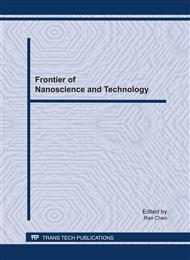[1]
R. Dieckmann: Philos. Mag. A Vol. 68. (1993), p.725.
Google Scholar
[2]
H. H. Kung, Transition Metal Oxides: Surface Chemistry and Catalysis(Elsevier, New York, 1989).
Google Scholar
[3]
L. Huo, W. Li, H. Cui, S. Xi, J. Wang, B. Zhao, Y. Shen, and Z. Lu: Chem. Mater. Vol. 12. (2000), p.790.
Google Scholar
[4]
P.T. Moseley, et al: Sensors and Actuators B Vol. 133 (2008), p.543–546.
Google Scholar
[5]
M. Fukazawa, H. Matuzaki, and K. Hara: Sens. Actuators B Vol. 12. (1993), p.133.
Google Scholar
[6]
K. K. Lepers: Vestn. Akad. Nauk SSSR Vol. 4. (1990), p.26.
Google Scholar
[7]
T. Lindgren, H. Wang, N. Beermann, L. Vayssieres, A. Hagfeldt, and S. -E. Lindquist: Solar Energy Mater. Solar Cells Vol. 71. (2002), p.231.
DOI: 10.1016/s0927-0248(01)00062-9
Google Scholar
[8]
G. Bate and E. D. Wohlforth, Ferromagnetic Material (North-Holland, Amsterdam, The Netherlands , 1980).
Google Scholar
[9]
R. M. Cornell and U. Schwertmann, The Iron Oxides, Structure, Properties, Reactions, Occurence and Uses, VCH, Weinhein, (1996).
Google Scholar
[10]
R. Takagi: J. Phys. Soc. Jpn. Vol. 12, (1957), pp.1212-1218.
Google Scholar
[11]
A. G. Goursat and W. W. Smeltzer: Oxid. Met. Vol. 6. (1973), p.101.
Google Scholar
[12]
Y. Fu, J. Chen, and H. Zhang: Chem. Phys. Lett. Vol. 350. (2001), p.491.
Google Scholar
[13]
S. Lian, E. Wang, Z. Kang, Y. Bai, L. Gao, N. Jing, C. Hu, and L. Xu: Solid State Commun. Vol. 129. (2004), p.485.
Google Scholar
[14]
Y. Y. Fu, R. M. Wang, J. Xu, J. Chen, Y. Yan, A. V. Narlikar, and H. Zhang: Chem. Phys. Lett. Vol. 379, (2003)pp.373-379.
Google Scholar
[15]
X. Wen, S. Wang, Y. Ding, Z. L. Wang, and S. Yang: J. Phys. Chem. B Vol. 109. (2005), pp.215-220.
Google Scholar
[16]
H. Srivastava, P. Tiwari, A. K. Srivastava, andR. V. Nandedkar:J. Appl. Phys Vol. 102. (2007), p.054303.
Google Scholar
[17]
U. Cvelbar, Z. Chen, M. K. Sunkara and M. Mozeti : Small Vol. 4. (2008), p.1610.
Google Scholar
[18]
L. -C. Hsu, Y. -Y. Li and C. -Y. Hsiao: Nanoscale Res. Lett Vol. 3. (2008), p.330.
Google Scholar
[19]
Q. Han, Y. Y. Xu, Y. Y. Fu, H. Zhang, R. M. Wang, T. M. Wang and Z. Y. Chen: Chem. Phys. Lett Vol. 431. (2006) , p.100.
Google Scholar
[20]
I.R. Beattie, T.R. Gilson: J. Chem. Soc A Vol. 5. (1983), p.980.
Google Scholar
[21]
D. Zhao,P. Kashkarov and Han Zhang: Nanoscale Vol. 2. (2010), pp.524-528.
Google Scholar


